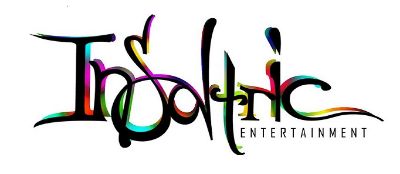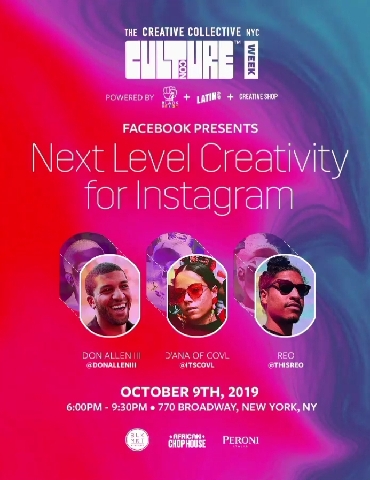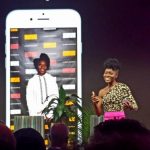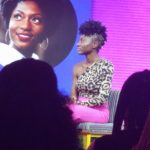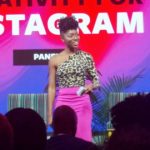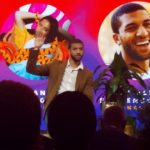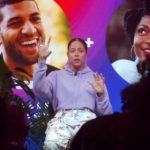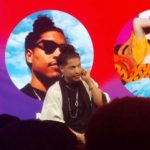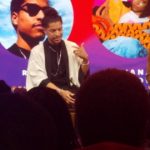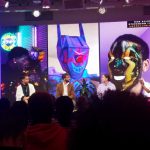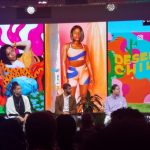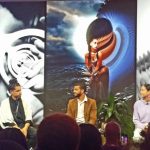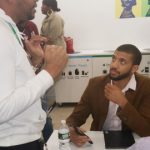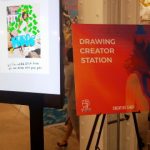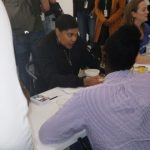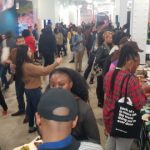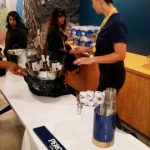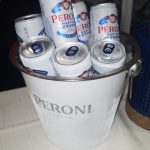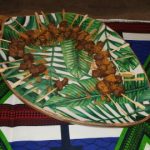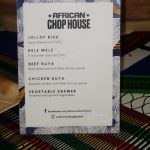Creatives received a real chuck full of advice and knowledge from the talented panelists (Reo, D’Ana of COVL, Don Allen III with moderator Nana Bediako) while drinking smooth tasting Italian beer, Peroni and satisfying their hunger with African Chophouse’s Jollof Rice (spicy stewed rice), Kele Wele (fried sweet plantain), Beef Suya (beef seasoned with African spices), Chicken Suya (roasted chicken with West African spices), Vegetable Skewers (roasted and spiced vegetables).
Here are SOME of what was discussed, shared and lessons learned:
- The importance of learning and understanding augmented reality (AR) as quick as possible whether you are in tech or not.
- Using AR can change the way you see music videos.
- Using social media to get a head start with (AR).
- Having followers and clients be part of the creation.
- How AR can be part of your business.
- Which program to easily start with.
- Panelists shared their massive failures.
- Lessons: Not everyone is your client. It’s perfectly fine to be all of you. Being told many no’s and don’t decide to settle, etc.
- Encouragement to do what makes you happy and listen to your intuition.
- Suggestions how to advance as a creative.
…AND A LOT MORE!
READ ALL WHAT THE PANELISTS HAD TO SAY BELOW:
NANA: We are so excited to be back at Culture Con and supporting CCNYC. My name is Nana Bediako. I work in the Creator Shop… and I work specifically on the entertainment vertical. So, it’s working with brands like Netflix, Spotify, NBA to help them make content for our platforms. Besides that, I have been with CCNYC from day one, which means that the very first culture con…I saw the power and the magic in the community at that time. So, when I started at Facebook, first thing, I went to my manager and literally in the first couple of months, I was like, “Y’all have to support this community somehow.” And surprisingly, they rose to the occasion and decided to actually put their money where their mouths are and support us as creatives of color because diversity and inclusion is important to them. What’s also important to them is to recruiting more of us brown and black people and being a part of the company.
At the Shop we are always talking to our partners how fast our platforms are moving. There’s 300 feet of content that people thumb through a day. That’s the height of the Statue of Liberty. The only thing that helps you to stand out is creativity. How visually different, how unique your content is, so you don’t get lost in the sauce.
Reo has been blessing us with art. His roots are in music production. He has written and produced for artists like Chris Brown, Bruno Mars, Jay-Z, Beyoncé. He is killing it in the game. If that was not enough, he’s also a visual artist. Things like the infinite zoom, motion cloning and augmented reality. An all around dope creative. Next we have D’Ana of Covl. D’Ana was an illustrator. She started on on our platform illustrating. Her vibrant work and combining photography with art really caught on scaling to her to the top of the list like creators on our platform. Then she started doing something different like taking what she was doing in the visual world and bringing it to the real world. Your roster of brands that you work with like Samsung, Nike. Then, you have Don Allen Stevenson III. He is an animation guru. He works at Dreamworks. He does that by day. But by night, he takes to our platform and use like Spark AR.
I want to start with you Reo…You have such a notable history in terms of music and the work that you done. Why would you even venture into becoming a visual artist and doing the work you have done? How did you make that transition?
REO: The irony is that, hmm, I started out as an illustrator. I was drawing my whole life as a kid and I was drawn to music. To me they were hand in hand. I couldn’t draw if there wasn’t music. And then as a dancer, I was listening in a different way, I think, to music. Whenever I was in art school, I ended up dropping out to start making beats. I don’t know what lead me to that. But then as I started working with people, it was always like ‘I see you doing an album cover’ or ‘what if we do this for a music video?’ I started to be between that gray area, both left brain and right brain. As I continued to make music for Beyoncé and such, it just hit me that I was visual and started making things with my own music…I just keep experimenting. I think a lot of times we’re stuck in a box that we have to do one thing really well…It gave me some confidence that I can be out here and say I do both. I worked with Beyoncé musically and visually. That was the biggest thing to me because it’s like you have to start from scratch…
NANA: What did you do with Yoncé, visually? I know you did that song, ah, “Hello” on Sasha Fierce visually.
REO: Yeah, I worked on Coachella show… Now I’m trying to call myself an audio visual artist like you come to me, I want to world build everything. What it looks like, what it sounds like.
NANA: Can you tell us a little about your style…
REO: Well, like I said, I started out drawing so I always had the creative mind in that way. When I was doing the music for a long time and I came back to art, I was like, let me try a different medium. Let me try video. Let me try something else. So, I was on Youtube all the time finding tutorials and experimenting. I remember, ah, I was just at a point that I was not getting the feedback I wanted from Instagram because I was posting these very abstract beautiful colored things. People would like it, but it wouldn’t go anyway. So, I read this article that people want to see themselves in the work. So, I started putting people. Once you find the thing that resonates and it also feels right to you, it becomes your style.
NANA: I always talk to you, our brands and partners in general about intentional experimentation. You’re not going to know what’s hot until you try it and find what really works for you. And that’s what all three of y’all have in common.
You D’Ana, for example, started off in just illustrating. Correct me if I’m wrong. Then you started doing it in photos and… now you start designing clothes. Help us understand, I guess, what is your creative process…? Do you think about the medium first and then the art after? How is it being a creative having so much tools to play with?
D’Ana: So a lot of times I like to start out with doing research. And when I say research, we often times feel like it’s boring. But sometimes, research for me is creating an entire visual mapping on my wall where I can see what the client wants and how we use ourselves artistically in there. Oftentimes our research means reading my books that often reference back to a lot of color theory….Sometimes research is taking myself out of my home and going to museums, to the park, walk with my dog. All of those times kind of [counts] as my research process. Once I get to the point when I feel confident, now going in a sketching session for 1 to 3 hours, I just sketching out until something just flys with me. And so, a lot of times it’s just me. Oftentimes with creativity, it is just you. Sometimes you don’t have this team big team to work off and that would be amazing if that was the case. With myself I am figuring out the next process or step or understanding what it I want to achieve artistically in a project keeping in mind what the client wants.
NANA: What has been your favorite project so far?
D’Ana: That’s tough. I would say my recent project with Mona PS1 was very cool because I got to step out of my comfort zone digitally and bring that work into a more physical space and see how it impacted people. Just seeing my work on a bigger scale just made me even realized there is nothing I can do.
NANA: So, I am going to talk about augmented reality. Because you can’t talk about next level creativity and not be that up. Help us understand those who are not in tech why they should even care about augmented reality?
DON ALLEN III: Augmented reality right now is when the smartphone was right around 2006 – 2007 where everyone is like, “I don’t know why I would use a smartphone.” “What’s the utility out of that?” Raise your hands if you have a smartphone. I think we are in a moment like that, but for augmented reality. If we do not jump on it right now and really, really hone in on it, we’ll get left behind.
NANA: I’m going to be real with y’all. Looking for augmented reality creators like brown and black ones like us, it was really hard. It’s almost like the influencer marketing game when I worked back at MTV, I would remember wanting to hire influencers for programs to come to the VMA’s. But our counterparts advanced so far passed us. They had millions of followers where as we were getting up and starting. So, this a perfect time to really check out and start testing augmented reality. Between Facebook and Instagram, you now have both platforms to work with it and it’s so easy in terms of not having to know how to code, but still do it.
And by the way you guys had your own augmented reality experience. How was it for just learning and making augmented reality filters for Instagram?
D’Ana: I think for me is always thinking how can I interact with my audience in a different language. As we understand now that we are so multifaceted, growing at such an incredible fast speed. For me, just thinking how can I interact with my audience on a different level where it allows us to feel like they are a work of art – that to me is like a game changer. Even diving in a new world that I didn’t even know knowledge of has turned into different mediums and for trial and error.
REO: For me it’s a little difficult. The numbers and a lot of math. But I knew I had to learn. I knew it was really frustrating, but I had to learn a little bit of time every day, messing with it and seeing what it does, what it can’t do. And even like in the future, as I like work with other creators that do it, I can communicate to them what I want to do as possible and even to the client because I started doing things with clients now. And they are like, “Hey, can you do this?” and I’m like, “Nah, not yet.” But you need to know. Kind of learn that software. It took me a minute to do that, but I think just like D’Ana said whenever you post something on Instagram, I think it’s like, “Ah, there he goes again posting something cool”, but people don’t give you that like. But when they are apart of it and they are smiling and you get to see a comment or like, that gave me so much motivation to keep going. It’s bigger than just getting a notification.
D’Ana: And also it tends to speak in our business, right? So as creatives or freelancers we’re thinking of many ways to make profit or sell my business. Now AR is part of that conversation, we now have brands coming us to us and saying, “Hey, I saw your filter? Can you do one for us? And that opens a whole different platform to scale your business in another way.
NANA: Another revenue stream.
D’Ana: Get that money.
DON ALLEN III: What I want to add to that is that I use a lot of 3D software and Spark AR is super friendly. It’s like your best friend right now. Get in that program and there are two tutorials downloaded in the program… and you can just watch them. You’ll see really quickly like “Oh I got artwork on my desktop and now its on my face.”
NANA: I have this theory that AR is soon going to become the new music video. Me personally, I do not watch music videos on TV anymore. But when I see people using AR in combination with music, I’m like, “Oh that is really cool.” So, it’s also helping me to test out music. Reo, do you see that being the projection in AR as it related to music, specifically?
REO: Yeah. Again. It’s going to be all your senses. I think when we can decorate this whole thing, you’ll constantly be in the whole video if you want to be. I think that I always looked at the world, the term world builder and that was something I was moving towards. I know that AR is one of the first steps in that way. Right now, it’s taking you visually to another place. As I make music, it’s like I want to put you in the place I was when I made it. I’m thinking about all those kinds of things.
NANA: Do you think we will get to a place where AR isn’t just a face filter. It actually adds utility to your daily life. And have you seen any examples of that so far on our platforms like Instagram and Facebook?
REO: …I’ve seen things where people can see like heart rates…that help them know when someone is choking.
DON ALLEN III: The couple of ones I see for utility are I do a lot of visual effects and supervising on my free time like projects and oftentimes I have to explain to a director or producer what I am going to put in that scene and they don’t see what I am seeing. So, what I plan on doing Spark AR this week I’m going to make some assets to have with me on set and hand the Instagram app to them and have them place the object where they want. And then I’ll say, “This is how you were imagining it? Well I was thinking of putting that with it.” Giving that utility to the person or the people what you are trying to explain it with to help them the visualization what you gonna to do. And it’s also nice for sharing purposes. Maybe that asset is fine and all you need for the shot. For me, I’m going to kinda use it for a visualization tool.
NANA: I want pivot real quick and talk about being a creative. You all made some kind of level at this point. But it was not always this way. D’Ana you smiling and laughing at me.
D’Ana: I feel that is my life story.
NANA: The point I’m trying to get to is that we’re celebrating our wins but at the end of the day as a creative there are plenty of failures and setbacks that you have to go through. So can you maybe share one of your career defining failures that you experience and how you were able to overcome something like that?
D’Ana: This experience taught me I’m not going to be everyone’s cup of tea. I’m not going to be everyone’s favorite artist. And I had a situation with a client where I was doing all this work and we prepped properly, we did all the resourcing, you name it we did it all. We were provided the last, final part of the project and she just was like “I don’t understand why people pay you this. I don’t understand why I hired you, xyz.” And mind you I did what to read her fulfilled, but at the end of the day, there is a certain professionalism I need to keep.There is a certain thing I need to keep – my morals, my respect, my dignity. So, I told her cool that’s fine. We ended the project. But it really told me that I’m not going to be everyone’s favorite cup of tea. Once I unlocked that mentality, it allowed me to express myself unapologetically in any format because I am speaking to people who do understand me, do understand the artistic and those are the people I want to continue talking to. Anyone outside of that, does not matter. It took me a good 4 years to learn that. You just got to create for yourself and everything else will follow.
DON ALLEN III: Let’s see. When I graduate from, ah, school. I apply to forty different motion graphic jobs and they all said “NO.” It made me feel like a bummer. I studied some stuff like this so I thought it would help. So flash forward, I followed what my family wanted, which is pretty standard kind of conservative job that paid the bills, but didn’t make me happy on the inside. And I was kind of doing it to make bread, but not really happy about the bread. I start realizing this and decided to trust my instinct and passion. I started looking into what I really cared about. I found this company called Parent Lab. They are making neuroscience videos for parents raising kids and you can use neuroscience when you’re raising them. And I was like, “That sounds freaking amazing. I will be so ecstatic to go to a job like that.” So, I quit the job that was paying more, took the job that paid way less, but I feel like excited to go to work every day. I was like “Yeah, I’m going to help some kids and the parents. Bond together as they grow.” And that gave me a lot of free time, when I came home to do live streaming. And on my live streams, I started creative software and I aimed my phone at my screen showing people how to use programs. I had so much more time. And believe it or not, I never applied to my animation studio. They found me through Instagram on my live streams. I wouldn’t even have that opportunity had I not looked in and said, Well I’m not being fulfilled spiritually, emotionally. I’m not happy here.” And so, I encourage you to do the same.
REO: For me, I have two really big, ah, loses. The first one was I had cancer like right in the middle of me making really big life decisions. I was making music, but nothing is taking off and I get this news I have Hodgkin’s Lymphoma. I had a tumor in my neck and it just kept growing. I had to stop everything of what was going on in my life and focus on that. What ended up happening was my intentions had changed. Before I was making music, I was wearing chains, Rocafella. And then all of a sudden, now my art is gonna be almost like a time capsule so for my family to visit me just in case I die. How can they immerse themselves in my art, my presence or whatever. And so I started to look at it differently. And then, the music that was coming out was a lot more passionate and I truly believe is what saved me in my life. And then, three months after I finished radiation, Beyoncé wanted one of the tracks I made. Again that was my first big placement ever. No one ever really hear of me.
The second thing I would say is like years into being a producer and living in LA and working, I started to get really discouraged because getting paid as a creative, you know, it’s not easy. So, when you do all the work and climb up the ladder and you shake the hands and accomplish things, you think it gets easier. But in my case, it didn’t. And I produced a track for Lil Wayne and Bruno Mars called Mirror, I don’t know if you guys hear that song.
NANA: Maybe.
REO: But it was my biggest accomplishment in my life at that time. The song was on the radio. Music video got 500 million plays. Everyone thinks I’m winning, but they never sent the check. So I got into a lawsuit with them that lasted 6 years…six figures and I have not seen any of it. That would discourage anyone to sit at a keyboard, computer to make things. What’s the point? Why am I doing this if it’s going to end this way? And that is when I started getting back into art. Well, I have to do something totally separate that I don’t have any emotions connected to. And so, I started using 3D software, after effects and start playing with it. I found my joy again to be creative. One of the biggest lessons I’ve learned in life – if you are waiting for it, it’s not coming. You have to work. You have to focus on something else. And all of a sudden, as soon as I didn’t need it, as soon as I moved to New York, Nike dm me, Dior dm me. All these people. As soon as that happened and I started making money again when I didn’t need music, of course, that’s when the lawsuit ended and they send me my money. Life is crazy like that.
NANA: That is law of attraction, right there…So I want to wrap this panel up just by talking about for the people in the room who are trying to level up their creativity and to advance it from where they are today, is there techniques that you can suggest to them in their own journey in order to get to that place?
D’Ana: I would say again, research. Get to know yourself as a creative. What do you like? What do you don’t like? Is there idols that you look up to, look at the work they’re doing. Dissect it to the “T” and figure out how they are approaching these different mediums…we have to educate ourselves because nobody else is doing it for us. And we are living in a very unconventional life. We are not doing the 9 to 5. We’re really gunning it, right now. So I think educating yourself, fall in love with your craft, experiment, fail, fail, fail and that is what helped me and I feel that will help other people.
NANA: Maybe a little winning.
D’Ana: Well, you definitely will be winning between all of that. Definitely, educate yourself and the winning will come seamlessly.
DON ALLEN III: Yeah, I would have to add to that, too. Give, give, give, ask. I always give a lot of things away. I can illustrate people. I would draw them. Give it away and want nothing in return. Maybe, something comes from it. But worst things happen is practicing what I have already been doing. I encourage to use a skill or craft or talent that you have to actually solve a problem from somebody else and want NOTHING in return. Then all of a sudden cool things can happen. Another one is get addicted to gratitude. If you make it a habit to like reward yourself for catching when you are grateful, it makes it really hard for anything to take you down even a notch….You do those two things. More tactical thing, I leave like voice messages on their dm’s with their name. It’s not their Instagram name. It’s the name that is displayed on their page. It personalize it and it shows you took an extra second to read who they are, take a look at their content. I got a lot more people to respond by doing that. But I always go in with a give first instead going, “Hey. Collab.” That won’t do it.
NANA: Yes! Great advice.
REO: I think I want to piggyback on the gratitude thing. What I see a lot is comparing ourselves. We look at Instagram all the time and you see they got more followers, they on the beach. You know that really can pull your spirit down. And you go there looking for inspiration and you leave worst than that before you picked up your phone. And I hear something today. It was a martial arts person. He was talking about in martial arts, when you see somebody better than you, you go to work. You get better because you know you are going to face this person. I feel we don’t do that. We see it and we go, “Ah, I’ll never get there.” And you make all these excuses. I think that there is enough space on the internet for everyone to be themselves. And to do exactly what you love. I tell people this in music, too. You got to write the song you want to write. Because whatever song you’re trying to stretch, people are already doing that naturally. So you are wasting your time. Just be the fuck you! Just be confident that you are going to shine. Because only you are going to that in that way.
NANA: That’s the word right there. All three of you. Well, thank you for your time.
Q&A
Audience Question: Thank you for speaking to us today. This was a lovely panel and Iearn a lot. Y’all talked about your creative process which was really helpful. But I wanted to know how you reach your target market because that is what is really hard for me. You create this dope content, but nobody is there…How you guys reach you own target market and what advice do you have for a micro influencer?
D’Ana: Sometimes what does not hit in my feed, does really well in my stories. Diversifying your content to fit a different format is what really works. My opinion, sometimes if my story does not reflect my feed and vice versa because I feel sometimes I speak to two different people. That consistency and crafting up your content in a different format is what I feel really helps.
DON ALLEN III: I recommend diversifying your work. Your style changes drastically post to post. So I am kind of testing what people like about this. What they don’t like about this? And looking at the metrics. You change all of your accounts to a business accounts, gets a lot of really good metrics on form breakdowns. When people are looking at it? And you can build little map in your head. What kind of content is who?
REO: For me I’ll say anything you post is a breadcrumb back to you later. If you notice, anybody that blow up, like Kendrick Lamar. People found him in Good Kid Mac City, but it you were a fan, you’ll knew 4, 5 mixtapes before. And you have to enjoy where you are. Because sometimes you’re not the big influencer, but you’re still reaching people that really fuck with you. Not because of the hype. You can get real engagement with people and get feedback and ask them. It’s like a real intimate connection. And I think that just be happy from where you are. Post and post and people may find you like in 2 years from now. Some of the biggest brands told me they was following me for 2 years before they ever reached out. That consistency and making sure it got that quality control. Post the work you want to get hired for, basically.
NANA: The only thing I would add to that is building on what you was saying about the analytics. Make sure you are using the analytics on our platform. We tell you everything from what day your audience is checking out your content. Also, check out what hashtags are trending on our platform and add that to your content so your content is searchable. Those are ways you can make yourself discoverable in different channels. So, definitely use those tools.
Audience Question: Like creatives, we can be our worst critics. As a show of hands, who in here deal with imposter syndrome? Okay, so you guys already gave such good advice. How are there tangible steps to tackle that?
D’Ana: Eliminate my use on any platforms. Sometimes when I become too distracted in that world, I need to subtract myself from that and get myself back into reality of things. Affiliate myself with people that support and see me for me. Imposter syndrome is all in your head. And you have to get out of your head. So anything you need to do that is self-care focus to get out of that, I would recommend get off the platform and be around people that support being you.
DON ALLEN III: You can reach to 5 people that know you best that you already know and ask them who you are. Document what they say and compare the similarities and differences. Get highlights of what people you can close with think of me and help me say like okay this is who I am. Do I agree with that?
NANA: Okay, these guys will be at the creators section, so please bring your questions there.
